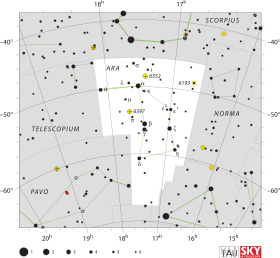HD 156091
HD 156091
| Ascension droite | 17h 19m 12,50730s[1] |
|---|---|
| Déclinaison | −59° 41′ 40,5989″[1] |
| Constellation | Autel |
| Magnitude apparente | 5,91[2] (5,91 + 13,00)[3] |
Localisation dans la constellation : Autel | |
| Type spectral | K2 IIICNIB/II[4] |
|---|---|
| Indice B-V | 1,37[2] |
| Vitesse radiale | −5,0 ± 0,4 km/s[5] |
|---|---|
| Mouvement propre |
μα = −3,15 mas/a[1] μδ = −8,05 mas/a[1] |
| Parallaxe | 1,31 ± 0,36 mas[1] |
| Distance |
~2 500 al (~800 pc) |
| Masse | 8,4 ± 1,0 M☉[6] |
|---|---|
| Luminosité | 4 266 L☉[7] |
| Température | 4 306 K[7] |
| Âge | 33,7 ± 8,6 a[6] |
Désignations
HD 156091 est une étoile double de la constellation de l'Autel. Le composant primaire est une étoile géante avec une magnitude 6 avec des raies de carbone, d'azote et de baryum plus fortes que la normale dans son spectre[8]. L'autre composant est une étoile de 13e magnitude à une séparation angulaire de 27,4" le long d'un angle de position de 275°, à partir de 2000[3].
Références
- (en) Cet article est partiellement ou en totalité issu de l’article de Wikipédia en anglais intitulé « HD 156091 » (voir la liste des auteurs).
- F. van Leeuwen, « Validation of the new Hipparcos reduction », Astronomy and Astrophysics, vol. 474, , p. 653–664 (ISSN 0004-6361, DOI 10.1051/0004-6361:20078357, lire en ligne, consulté le )
- P. M. Corben et R. H. Stoy, « Photoelectric Magnitudes and Colours for Bright Southern Stars », Monthly Notes of the Astronomical Society of South Africa, vol. 27, , p. 11 (ISSN 0024-8266, lire en ligne, consulté le )
- Brian D. Mason, Gary L. Wycoff, William I. Hartkopf et Geoffrey G. Douglass, « The 2001 US Naval Observatory Double Star CD-ROM. I. The Washington Double Star Catalog », The Astronomical Journal, vol. 122, , p. 3466–3471 (ISSN 0004-6256, DOI 10.1086/323920, lire en ligne, consulté le )
- ↑ Nancy Houk, Michigan catalogue of two-dimensional spectral types for the HD stars, (lire en ligne)
- ↑ G. A. Gontcharov, « Pulkovo Compilation of Radial Velocities for 35 495 Hipparcos stars in a common system », Astronomy Letters, vol. 32, , p. 759–771 (ISSN 1063-7737, DOI 10.1134/S1063773706110065, lire en ligne, consulté le )
- N. Tetzlaff, R. Neuhäuser et M. M. Hohle, « A catalogue of young runaway Hipparcos stars within 3 kpc from the Sun », Monthly Notices of the Royal Astronomical Society, vol. 410, , p. 190–200 (ISSN 0035-8711, DOI 10.1111/j.1365-2966.2010.17434.x, lire en ligne, consulté le )
- I. McDonald, A. A. Zijlstra et M. L. Boyer, « Fundamental parameters and infrared excesses of Hipparcos stars », Monthly Notices of the Royal Astronomical Society, vol. 427, , p. 343–357 (ISSN 0035-8711, DOI 10.1111/j.1365-2966.2012.21873.x, lire en ligne, consulté le )
- ↑ Philip C. Keenan, Sandra B. Yorka et Olin C. Wilson, « Recognition and classification of strong-CN giants. », Publications of the Astronomical Society of the Pacific, vol. 99, , p. 629–636 (ISSN 0004-6280, DOI 10.1086/132025, lire en ligne, consulté le )
Liens externes
- Ressource relative à l'astronomie :
